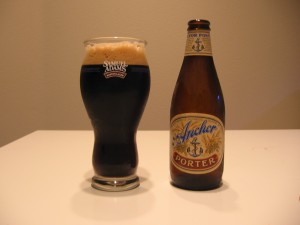Anchor Porter
By Anchor Brewing Company (San Francisco, CA)
12oz. bottle
5.6% ABV

Bottle Description:
San Francisco’s famous Anchor Porter brand is made in one of the smallest and most traditional breweries in the world by the brewers of Anchor Steam Beer. Our old-fashioned porter is virtually handmade, with an exceptional respect for the ancient art of brewing. We use 100% malted barley, generous amounts of fresh, whole hops, entirely natural carbonation and a simple, natural brewing process which is like no other in the world. The deep black color, the thick, creamy head and the intensely rich flavor of the Anchor Porter, made in San Francisco since 1974, have earned this delicious and unique brew a worldwide reputation for outstanding quality. It is aesthetically pleasing and wholly superior in every respect.
This beer can be found at any BevMo! or any beer-friendly liquor store. I fortunately got mine as a gift from my friend Joey who works next to me. I believe he had received this as an extra in a trade through Ratebeer.com so I wouldn’t know how old this beer is.
Anchor Brewing Company, rescued from bankruptcy in 1965 by Fritz Maytag, great grandson of the founder of the Maytag appliance company is internationally known for its original American West Coast style, the Steam Beer. This Steam Beer (also known as a California Common Beer) is often described superficially similar to an American pale or amber ale, but differs in that hop aromas/flavors are minty/woody rather than the usual American citrus hop varieties and have toasty/caramel-like malt flavors. The unique process in which this beer is fermented also contributes to its exceptional taste. Due to the lack of refrigeration during its time of creation, large open shallow fermenters were traditionally used in attempt to keep the fermenting beer as cool as possible for their lager yeasts. Lager yeasts, which operate best in temperatures 46’F-56’F (in comparison to ale yeasts which prefer 55’F-75’F), had problems fermenting properly in the San Francisco Bay area. Eventually, the lager yeast strain they were using had been selected to thrive at the cool end of normal ale fermentation temperatures thus leading to its hybrid qualities. Furthermore even after thoroughly describing a traditional American beer’s history, I won’t be reviewing Anchor Steam since I’m sure almost everyone in California has had one of these. If not, go out and buy one.
Moreover, Anchor Brewing Company also produces another original style, a precursor to the Stout, the Robust Porter. The Porter originated in England and was favored by laboring classes such as the “porter” class and other physical laborers. Brewing authors agree that the original Porters were produced with brown malt; malt dried over a wood fire at fairly high heat. These Porters were known as Brown Porters and differed from Robust Porters in that they were softer, sweeter, and more caramelly in flavor and usually had less alcohol. Very similar to a Brown Ale, but with more roast. As the popularity of the Brown Porter declined due to the rise of the Stout, the Robust Porter led the comeback for this style as it was stronger, hoppier, and roastier version and was designed as a historical throwback or American interpretation. So what’s the difference between a Stout and Porter? I’ve asked many brewers (professional and homebrewers) and still have no clear answer. Depending on where and what brewery you get your Porter, the taste can be really similar to a Stout or vary greatly. In terms of ingredients, unmalted roasted barley only exists in a Stout’s ingredients. In terms of taste, the difference varies. Yet, these days Stouts are served using nitrogen (thanks to Guinness, Beamish, and Murphy’s) instead of carbon dioxide. One brewery’s stout may taste like another brewery’s porter. The Stout evolved from attempts to capitalize on the success of London’s Porters, but reflected a fuller-bodied, roastier, drier, creamier, and usually with more alcoholic content. Still, it’s nice to see Anchor Brewing Company bringing back an underrated historical style.
Anchor Porter pours out very dark brown almost black but has slight mahogany highlights when held up to the light. Opacity is very difficult to determine with its dark color. The head color is brown with creamy bubbles and retains itself strongly. The malt aroma is dominated by toffee-like, caramel, and some dark fruit/raisin flavors. There is a light oxidation in this beer as I can smell some sherry-like notes. Hop aroma is vaguely distinguishable and is definitely not a highlight in this style. Low traces of diacetyl (buttery, popcorn-like smell) is present but is acceptable to style. After the first sip, medium-sweet caramel and toffee flavors overwhelms the palate and is mildly supported by some hop and dark malt/roast bitterness. The finish ends moderately dry and light roasted malt flavor lingers. The mouthfeel is medium-full bodied with a moderate level of carbonation. A slight alcoholic warmth is noticed but not detracting from overall mouthfeel. No astringency from roasted grains is perceived in both the flavors and mouthfeel. Despite being considered a Robust Porter, Anchor Porter flavors do not emphasize roastiness but more on sweet caramel, toffee, and chocolate attributes . This may not be the best example of Anchor Porter given its slight oxidation from age but it definitely brings out more complex malt flavors you wouldn’t normally find in a fresh bottle.
Category 12B: Robust Porter
Aroma: 9/12
Appearance: 3/3
Flavor: 16/20
Mouthfeel: 5/5
Overall: 8/10
Total: 41/50
– Ant




 Posted by antiny
Posted by antiny 




